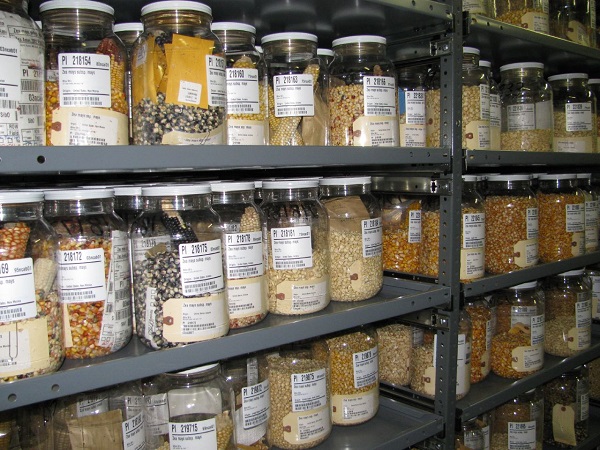| The Sandisfield Times |
|---|
| Seed Collection/Research at Risk
Short-Sighted Cost Cutting |
|
By Tom Christopher Published May 1, 2025 |
|
If you are a gardener like me, you are probably starting vegetables and fruits from seed right now. We gardeners take for granted the appearance of new and improved varieties that make our food growing easier every year, like the new tomatoes I'll be starting soon which have a resistance to the blight which attacked my patch last year. We take such advances for granted, just as we take for granted full bins in the produce section of our supermarkets. If you are one of our local farmers, such support often makes the difference between a bumper harvest versus crop failure. All these things, though, are under threat, thanks to the budget cutters in Washington who recently zeroed-out the staff of the National Plant Germplasm System. The financial savings from this cut will be negligible: the total annual budget of this program was $40 million, less than half the cost of a single new jet fighter. The consequences, however, are going to be immeasurable. Founded in 1898, the National Plant Germplasm System (NPGS) as of January of this year included 600,000 strains of 200 different species of crop plants. That may seem excessive to a DOGE budget cutter, but as Dr. Iago Hale, a crop plant breeder at the University of New Hampshire explained to me in a conversation I recorded for my podcast, "Growing Greener," the expansiveness of the collection is precisely its strength. Consider the NPGS, he said, as a library of solutions. The genetics of our foundational food crops are intentionally narrow. Farmers want to grow only the most productive strains and they want them to flourish under current conditions and ripen on a prescribed schedule. |

|
|
The farmers' enemies, crop diseases, follow the opposite strategy. They are genetically fluid, constantly evolving to overcome the plants' natural defenses and develop immunity to the farmers' protective sprays. When that happens, plant breeders have gone to the NPGS collections to find strains of the endangered crop that have a natural resistance to the new disease variant and bred those genetics into the commercial seed strains. This is exactly what saved the global wheat crop, Dr. Hale added, in 1999 when a new variant of stem rust, a devastating fungal disease of that grain, appeared in Uganda. That may seem a long way from America's breadbaskets in the Great Plains and the Pacific Northwest, but fungal spores, once swept up into the upper atmosphere, can float for thousands of miles. By identifying resistant wheat strains in the NPGS collection and interbreeding them with existing favorites, however, plant breeders were able not only to save the harvest of Ugandan farmers but also those of farmers around the world. In one essential respect, Dr. Hale pointed out, the NPGS collection is unlike a library. What the NPGS has collected are living materials, and as such, they will die unless carefully tended. Skilled management is needed to periodically renew the stored plant materials. Seeds may last for years if kept at the proper temperatures and humidities, and some plant materials will survive a long time when frozen in liquid nitrogen. Other crops are more perishable. Potato strains can only be maintained by planting out and harvesting every year. Even the genetic integrity of those durable seeds may be lost if planted out improperly so that they cross-pollinate with relatives. When the NPGS scientists were fired, the ability to curate the collection in this manner stopped, and unless this is restored soon, strains we will need to combat future challenges, including those caused by climate change, will begin to die. Many of the strains that will be lost are virtually unavailable from any other source and may be otherwise extinct. A very pertinent example of the consequences of neglecting genetic diversity of crop plants is presented by Ireland. In 1845, the Irish relied for their sustenance on a handful of potato varieties, with the "Lumper," one highly productive clone dominating production throughout the country. Unfortunately, none of these had any resistance to a fungal blight (the same disease now afflicting my tomatoes) whose spores blew into the country that year. The crop failure was nearly complete for the next seven years. A million people died of famine and associated diseases, and two million more emigrated. It took a couple of decades for resistant potato cultivars to be identified and integrated into breeding blight-resistant alternatives to the "Lumper," and Ireland's population has never recovered to pre-Famine levels. A judge has ordered the re-hiring of the NPGS scientists who were laid off by DOGE, but so far, this has not occurred. That collection of crop germplasm was, according to Dr. Hale, the envy of the world. Will we have to wait for an Irish-style catastrophe before we recognize what we are willfully throwing away? |
|
Write to Somebody If you agree with Tom that eliminating the NPGS could have a serious impact on U.S. and world agriculture, write or email our national representatives, Senators Elizabeth Warren and Edward Markey and Representative Richard Neal. Their addresses are easily found online or simply addressed to the U.S. Senate, Washington, D.C., 20510 or the House of Representatives, Washington D.C., 20515. All accept email, if you prefer, and phone calls. |
©The Sandisfield Times. All rights reserved.
Published May 1, 2025
